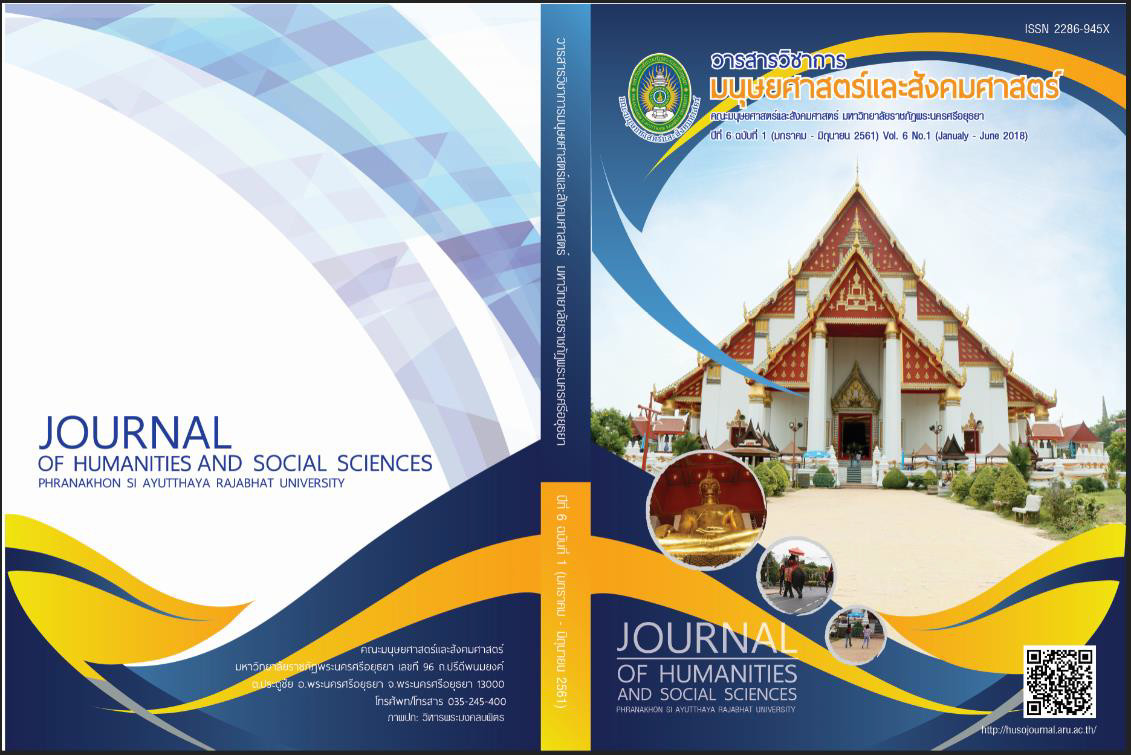บทบาทสถาบันการเงินชุมชน ในการแก้ไขปัญหาความยากจน
Main Article Content
บทคัดย่อ
สถาบันการเงินชุมชน คือ ระบบการเงินในระดับจุลภาค ที่เน้นในเรื่องของการปล่อยสินเชื่อจำนวนเล็กๆ ให้แก่คนยากจนและผู้มีรายได้น้อย โดยให้ความสำคัญกับการสร้างทุนทางสังคม ซึ่งประเทศไทยได้นำแนวคิดเรื่องสถาบันการเงินชุมชนมาใช้เป็นเครื่องมือในการแก้ไขปัญหาความยากจน โดยเริ่มต้นจากกลุ่มออมทรัพย์ พัฒนาไปเป็นกองทุนชุมชน และธนาคารประชาชนตามลำดับ จากการดำเนินงานพบว่า สถาบันการเงินชุมชนช่วยในการแก้ไขปัญหาความยากจนในเชิงบวก กล่าวคือ สามารถสร้างงาน สร้างรายได้ให้แก่สมาชิก แต่ก็ยังประสบปัญหาในเรื่องของการบริหารจัดการด้วยตนเอง ซึ่งหน่วยงานภาครัฐควรจะให้การสนับสนุนในเรื่องขององค์ความรู้ที่จะใช้ในการบริหารจัดการ เพื่อให้สถาบันการเงินชุมชนเป็นสถาบันที่มีเสถียรภาพอย่างแท้จริงและสามารถดำเนินงานไปได้อย่างยั่งยืน
Article Details

อนุญาตภายใต้เงื่อนไข Creative Commons Attribution-NonCommercial-NoDerivatives 4.0 International License.
บทความที่ได้รับการตีพิมพ์เป็นลิขสิทธิ์ของ คณะมนุษยศาสตร์และสังคมศาสตร์ มหาวิทยาลัยราชภัฏพระนครศรีอยุธยา
ทัศนะและความคิดเห็นที่ปรากฏในบทความในวารสารฯ ถือเป็นความรับผิดชอบของผู้เขียนบทความ และไม่ได้เป็นทัศนะและความรับผิดชอบของ กองบรรณาธิการ หรือ ของ มหาวิทยาลัยราชภัฏพระนครศรีอยุธยา
เอกสารอ้างอิง
รุจิราพร หงษ์ทอง. (2558). “การพัฒนากลยุทธ์การส่งเสริมการดำเนินงานกลุ่มออมทรัพย์เพื่อการผลิตในจังหวัดนครสวรรค์”. วารสารวิจัยและพัฒนาวไลยอลงกรณ์ในพระบรมราชูปถัมภ์ สาขามนุษยศาสตร์และสังคมศาสตร์. 10 (2) : 111-120.
สุชา ศิริจันทร์ชื่น และ ศิวัช ศรีโภคางกุล. (2560). “การศึกษาความสำเร็จของการบริหารงานกลุ่มออมทรัพย์เพื่อการผลิตในพื้นที่จังหวัดขอนแก่น”. วารสารสถาบันวิจัยพิมลธรรม. 4 (1) : 61-72.
Akanji, O. O. (1995). “Micro-finance as a strategy for poverty reduction”, CBN Economic & Financial Review. 39 (4).
Conroy, J. D. (2003). The Challenges of Microfinancing in Southeast Asia. Singapore: Institute of Southeast Asian Studies.
Chambers, R. (1983). Rural Poverty: putting the last first. New York: Longman.
Chambers, R. (1989). “Vulnerability, coping and policy”, IDS Bulletin. 20 (2) : 1-7.
Chambers, R. (1995). “Poverty and livelihoods: whose reality counts?”, Environment and Urbanization. 7 (1) : 173-204.
Chen, M. A. and Snodgrass, D. (1999). An Assessment of the Impact of SEWA Bank in India: Baseline Findings. Harvard Institute for International Development.
Erhardt, W. (1999). Credit for Poor and Low-Income Entrepreneurs in Urban and Rural Northern Thailand. Discussion Paper No. 99/4. Institute of Agricultural Economics and Social Sciences in the Tropics and Sub-tropics. University of Hohenheim.
Huerta, A. de la (2010). Microfinance in Rural and Urban Thailand: Policies, Social Ties and Successful Performance. University of Chicago.
Hulme, D. and Mosley, D. (1997). “Finance for the Poor or Poorest? Financial Innovation, Poverty and Vulnerability” In Wood, G. D. and Sharif, I. A. (eds.) Who Needs Credit? Poverty and Finance in Bangladesh. Dhaka: The University Press.
Kaboski, J. and Townsend, R. (2005). “Policies and Impact: An Analysis of Village-Level Microfinance Institutions”, Journal of the European Association. 3 (1) : 1-50.
Marr, A. (2003). “A Challenge to the Orthodoxy Concerning Microfinance and Poverty Reduction”, Journal of Microfinance. 5 (2) : 7-42.
Morduch, J. and Haley, B. (2002). Analysis of the Effects of Microfinance on Poverty Reduction. NYU Wagner Working Paper No.1014. The Canadian International Development Agency.
Moser, C. O. N. (1998). “The Asset Vulnerability Framework: Reassessing Urban Poverty Reduction Strategies”. World Development, 26 (1) : 1-19
Nussbaum, M. (2002). “Capabilities and social justice”. International Studies Review, 4 (2) : 123-135
Oracion, R. (2010). Sizing up your own needs: Global standards or local control in microfinance?. Annual Program Review 2010. World Vision Australia.
Perdana, A. A. (2005). Risk Management for the Poor and Vulnerable. CSIS Working Paper Series. Jakarta : Centre for Strategic and International Studies.
Ravallion, M., Chen, S. and Sangraula, P. (2008). Dollar a Day Revisited. Policy Research Working Paper 4620. The World Bank Development Research Group. Washington DC : The World Bank.
Robinson, M. (2001). The Microfinance Revolution: Sustainable Finance for the Poor. Washington, D.C. : The World Bank.
Sen, A. K. (1985). Commodities and Capabilities. Oxford : Elsevier Science.
Sen, A. K. (1999). Development as freedom. Oxford : Oxford University Press.
Sengupta, R. and Aubuchon, C. P. (2008). “The Microfinance Revolution: An Overview”, Federal Reserve Bank of St.Louis Review. 90 (1) : 9-30.
Schaaf, R. (2010). “Financial efficiency or relational harmony? Microfinance through community groups in northeast Thailand”, Progress in Development Studies. 10 (2) : 115-129.
Schaaf, R. (2010). “Do Groups Matter? Using a Wellbeing Framework to Understand Collective Activities in Northeast Thailand”, Oxford Development Studies. 38 (2) : 241-257.
Shigetomi, S. (2006). Organizational Capability of Local Societies in Rural Development: A Comparative Study of Microfinance Organizations in Thailand and the Philippines. Discussion Paper No.47. Institute of Developing Economies. Japan.
Thomas, A. (2000). “Poverty and the end of development” In Allen, T. and A. Thomas (ed.) Poverty and Development into the 21st Century. Oxford: Oxford University Press.
Worakul, W. (2006). Community-Based Microfinance: An Empowering Approach Towards Poverty Alleviation and Community Self-Reliance. Bangkok : UNDP.


